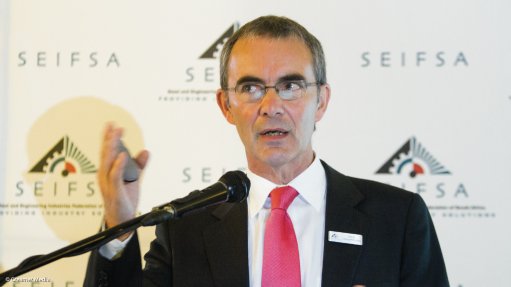
Seifsa chief economist Henk Langenhoven
Photo by: Duane Daws
Despite a marked increase in South Africa’s gross domestic product (GDP) during the third quarter of the year, the Steel and Engineering Industries Federation of Southern Africa (Seifsa) chief economist Henk Langenhoven warned that “very concerning trends” were in play that lent doubt to the actual credibility of a potential 3.5% growth rate.
Statistics South Africa this week revealed that the economy had improved by an adjusted 0.5% in the second quarter of the year to 1.4% in the third quarter.
While the adjusted second-quarter growth was in line with the latest estimates presented by Finance Minister Nhlanhla Nene earlier this year in the Medium-Term Budget Policy Statement, overall performance remained “very disappointing”, he said.
Langenhoven said the latest restated and rebased manufacturing data showed stagnation in the sector’s growth rates since 2010, with manufacturing production recovery only now reaching pre-2008 levels.
“The 2010 data reflected recovery after a contraction of 10.6% in 2009. Annual expansion slowed down from 5.9% in 2010 to 2.9% in 2011, 1.9% in 2012 and 0.7% 2013, with the three quarters of 2014 contracting by 0.2%.”
However, Langenhoven pointed out that “the volatility is something to behold,” citing seasonally adjusted quarterly growth fluctuating between 6% and -1.2% in 2012, and between 12.3% and -8% in 2013.
The current year to date “simply” recorded contractions in the sector to different degrees.
“Quarter one was -6.4%, quarter two was -4% and quarter three was -3.4%,” he stated.
“These are, indeed, very concerning trends,” Langenhoven said.
The metals and engineering sector experienced a similar trend with a contraction of 21% in 2009 before recovering to growth of 4.3% in 2010. In 2011 and 2012, growth slowed to 4.1% and 0.2% respectively before registering an uptick of 2.6% in 2013.
However, a contraction of 2% was experienced in the first three quarters of 2014, leaving metals and engineering production “still 12% below the 2008 peak”.
“Coinciding indicators, such as capacity utilisation and employment numbers, confirm the difficult trading conditions within the sluggish domestic economy and tentative world economic recovery,” said Langenhoven.